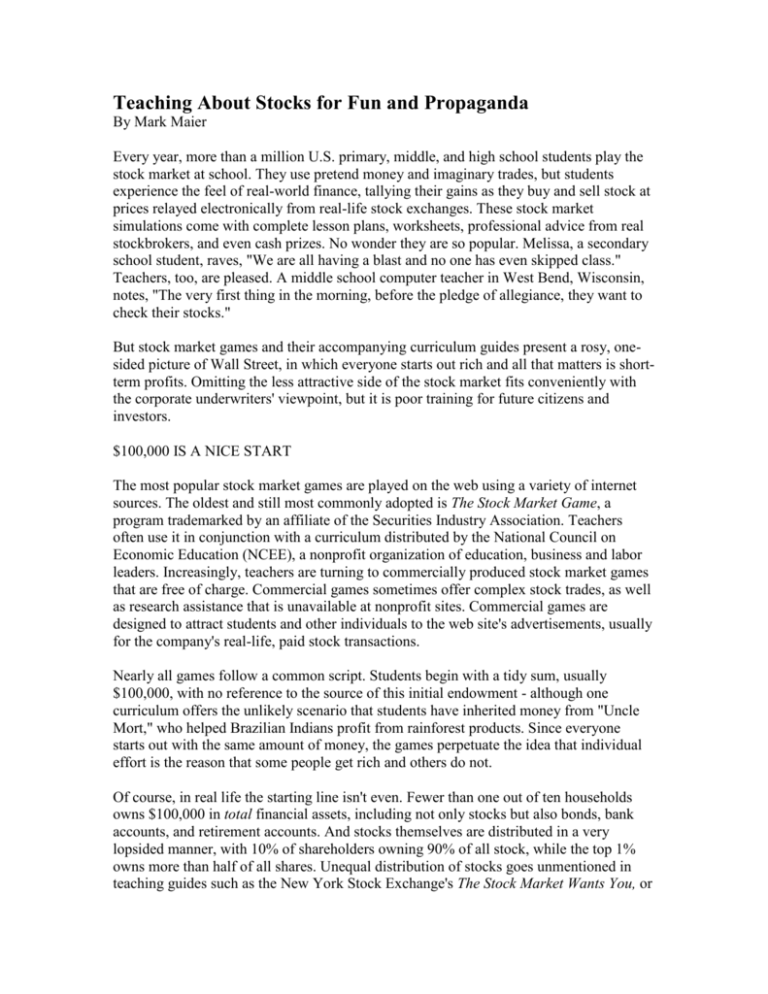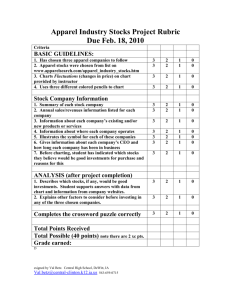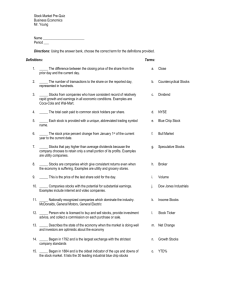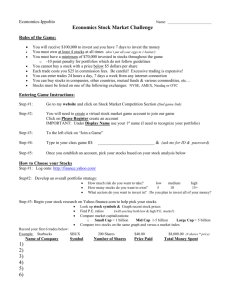Teaching About Stocks for Fun and Propaganda
advertisement

Teaching About Stocks for Fun and Propaganda By Mark Maier Every year, more than a million U.S. primary, middle, and high school students play the stock market at school. They use pretend money and imaginary trades, but students experience the feel of real-world finance, tallying their gains as they buy and sell stock at prices relayed electronically from real-life stock exchanges. These stock market simulations come with complete lesson plans, worksheets, professional advice from real stockbrokers, and even cash prizes. No wonder they are so popular. Melissa, a secondary school student, raves, "We are all having a blast and no one has even skipped class." Teachers, too, are pleased. A middle school computer teacher in West Bend, Wisconsin, notes, "The very first thing in the morning, before the pledge of allegiance, they want to check their stocks." But stock market games and their accompanying curriculum guides present a rosy, onesided picture of Wall Street, in which everyone starts out rich and all that matters is shortterm profits. Omitting the less attractive side of the stock market fits conveniently with the corporate underwriters' viewpoint, but it is poor training for future citizens and investors. $100,000 IS A NICE START The most popular stock market games are played on the web using a variety of internet sources. The oldest and still most commonly adopted is The Stock Market Game, a program trademarked by an affiliate of the Securities Industry Association. Teachers often use it in conjunction with a curriculum distributed by the National Council on Economic Education (NCEE), a nonprofit organization of education, business and labor leaders. Increasingly, teachers are turning to commercially produced stock market games that are free of charge. Commercial games sometimes offer complex stock trades, as well as research assistance that is unavailable at nonprofit sites. Commercial games are designed to attract students and other individuals to the web site's advertisements, usually for the company's real-life, paid stock transactions. Nearly all games follow a common script. Students begin with a tidy sum, usually $100,000, with no reference to the source of this initial endowment - although one curriculum offers the unlikely scenario that students have inherited money from "Uncle Mort," who helped Brazilian Indians profit from rainforest products. Since everyone starts out with the same amount of money, the games perpetuate the idea that individual effort is the reason that some people get rich and others do not. Of course, in real life the starting line isn't even. Fewer than one out of ten households owns $100,000 in total financial assets, including not only stocks but also bonds, bank accounts, and retirement accounts. And stocks themselves are distributed in a very lopsided manner, with 10% of shareholders owning 90% of all stock, while the top 1% owns more than half of all shares. Unequal distribution of stocks goes unmentioned in teaching guides such as the New York Stock Exchange's The Stock Market Wants You, or the NCEE's Learning from the Market. Instead, these manuals emphasize the recent broadening of stock ownership, so that 50% of households now own stock. A true-to-life stock market simulation would show that, while it is true that more U.S. households own some stock than in the past, ownership has become even more unequal: The rich now own an even larger percentage of all stock than they did 20 years ago. SHORTSIGHTED AND RISKY Even for the small number of students who one day will own a substantial amount of stock, the games are poor practice for real-world investing. The short time period during which students buy and sell stocks - typically eight to 12 weeks to fit comfortably in a school term - means that students focus on short-term gains. Professional advisors recommend a much longer-term perspective, holding stock for a decade or more in order to avoid periodic downturns in stock prices. In addition, stock market games reward students who take excessive risks. Analysis of game winners shows that the best strategy is for students to ignore diversification owning stock in a variety of corporations, which is the starting point for all prudent investment. By focusing on a few stocks known to swing wildly in price, some students, either through blind luck or an ill-advised risky portfolio, will end the game with big winnings, beating students who took the safer, diversified route. When it became apparent that students with such careless investments consistently won stock market competitions, some games forced students to invest in at least four stocks and to make a minimum number of trades. But the winning strategy remains to gamble as much as possible. Most students take a naïve approach, choosing portfolios based on brand names they know - McDonalds, Colgate-Palmolive, and Disney in one typical Boston seventh-grade classroom. The training manuals accompanying the best-selling games tell students that they will win if they carefully study these corporations. Several games use McDonalds as an example, suggesting that if students saw the burger chain introduce a popular new menu item, then this would be a good time to buy McDonalds stock. No expert would agree. If McDonalds' profitability improves because of a new menu item, then other stock investors would have already purchased McDonalds stock, pushing up the price to a point where further gains are unlikely. Economists debate the full impact of this effect. It may be possible for a few experts, or those with privileged access to new information, to buy and sell stock with above-average success. Alternatively, the stock market may behave irrationally, not following the wisdom of any investor. But it is well proved that the strategy recommended for students - buying and selling stocks based on readily available information - is no better than a random choice of stocks and, on average, will cause students to lose because profits are reduced by broker's fees. In a typical classroom, the stock market's random fluctuations will ensure that a handful of students will do well, tallying high profits and winning prizes put up at commercial web sites. Pride in such gains is misplaced. Students with losing stocks may feel an undeserved sense of personal failure, wrongly perceiving themselves as less clever than the game winners. When they are adults, students may expect the same returns earned by the lucky few, a lesson no more valid than if students practiced betting on horses. The stock market game's easy profits also might make students more receptive to recommendations to privatize Social Security. After all, if investing is simple and fun, wouldn't we be better off making individual decisions about our retirement funds? In the real world, privatization would be inequitable, risky, and more costly than a simulation game in which everyone starts off with the same $100,000 and there are no penalties for a losing investment strategy. (See "Special Section: Social Security," D&S, May/June 1999.) It is easy to see why teachers want to take advantage of student interest in stocks. Algebra teacher Tony Smith explains: "I have never seen kids so excited to come to class." Stock market simulations grab students' attention with real-world applications of math and research skills. The games can also be used to teach economics. However, rather than asking students to pick a winning portfolio, teachers should use the stock market to show students the actual workings of corporate America. For example, reading the stock pages could help students to see corporate ownership behind popular name brands. Beginning with Oscar Mayer wieners, a student will learn that they are produced by Philip Morris, the same corporation that owns Marlboro, Miller beer, and Velveeta cheese. These examples would show students the power over food marketing held by corporations such as the Philip Morris-Kraft conglomerate, and the problems of its recent merger with Nabisco foods. UP WITH STOCKS The instructor's manuals that accompany stock market games puff up the importance of stock markets in the U.S. economy, implying incorrectly that stocks are the source of most new corporate investment. Instead, retained profits or bank loans, not new stock issues, are the preferred source of funding for new plant and equipment. In fact, U.S. corporations have been buying back their own stock in order to keep stock prices high. As a result, the stock market is an overall drain on corporations' ability to build for the future. Stock market games also teach that buying stock gives one "ownership" of a corporation, that is, voting rights in decision-making. As one student put it, "I thought it was so cool I owned a part of McDonalds." The reality is that corporate governance is a complex process, with decision-making split between management and those with large numbers of shares. Sometimes a major shareholder will intervene in corporate decision-making. For example, in January, when the Gateway computer company was doing poorly, Ted Waitt - who owned nearly a third of the stock - took over as chief executive. But small shareholders, even when they act collectively, rarely influence company policy. Instead of perpetuating the myth of shareholder democracy, a better curriculum would ask students to find out how a local corporation decides to introduce a new product or move its production facilities. THE CASINO ECONOMY Finally, stock market games almost never explore the problems caused by speculation. A 15-year-old Mamaroneck, New York, high school student explained: "It was so cool… my money could make money without me doing anything!" This attitude, held by realworld investors as well, worries many economists who predict that the current bubble will burst, bringing down stock prices and likely causing a recession. Remarkably, such possibilities are not mentioned in any of the leading teacher manuals. Instead, the stock market is portrayed as a wise judge, rewarding those who make the right choices. An accurate curriculum would point out that speculation is not only risky for individual investors but also potentially harmful for the entire economy, since it might divert funds from socially useful purposes. One can easily imagine an exciting simulation game that includes the real-world possibility of prices first rising irrationally, only to fall when investors lose confidence. Students might buy and sell stocks as quickly as they can, passing the hot stock to someone else - until the bubble bursts and the stocks are worthless. For some purposes like teaching math, stock market games provide a dose of reality. Brad, a sixth grader in Pasadena, California, points proudly to the stock chart he keeps at home: "It wasn't math; we used percentages and multiplication to figure out how much we made." It might be too much to expect schoolteachers to pass up such an easy way to spice up a humdrum class. Certainly, the lure of a compelling game, along with glitzy corporate-sponsored lesson plans, is attractive to overworked teachers. But if students are to learn how the economy actually works, then teachers need to use stock market games with great caution, supplementing them with alternative activities to show the real world of unequal resources, impotent small shareholders, and reckless speculative bubbles. Resources: The Stock Market Game ; CNBC's Student Stock Tournament ; Final Bell ; Virtual Stock Exchange ; MarketPlayer.com ; Stocktrak ; Wall Street Sports ; Hollywood Stock Exchange ; Good News Bears Stock Market Project ; Edustock ; Invest Smart From www.dollarsandsense.org






